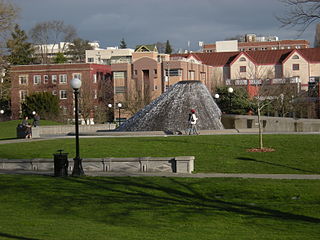
Louise Joséphine Bourgeois was a French-American artist. Although she is best known for her large-scale sculpture and installation art, Bourgeois was also a prolific painter and printmaker. She explored a variety of themes over the course of her long career including domesticity and the family, sexuality and the body, as well as death and the unconscious. These themes connect to events from her childhood which she considered to be a therapeutic process. Although Bourgeois exhibited with the abstract expressionists and her work has a lot in common with Surrealism and feminist art, she was not formally affiliated with a particular artistic movement.

Depictions of nudity include all of the representations or portrayals of the unclothed human body in visual media. In a picture-making civilization, pictorial conventions continually reaffirm what is natural in human appearance, which is part of socialization. In Western societies, the contexts for depictions of nudity include information, art and pornography. Information includes both science and education. Any ambiguous image not easily fitting into one of these categories may be misinterpreted, leading to disputes. The most contentious disputes are between fine art and erotic images, which define the legal distinction of which images are permitted or prohibited.

Gerard "Gerry" Tsutakawa, son of artist George Tsutakawa, is an accomplished Pacific Northwest sculptor. A studio apprentice for his artist father for 20 years, Gerry created his own first commissioned work in 1976. In the same studio where his father worked, he continues to design and fabricate anything from small studio bronze pieces to large public art fountains and sculptures.

The Olympic Sculpture Park, created and operated by the Seattle Art Museum (SAM), is a public park with modern and contemporary sculpture in downtown Seattle, Washington, United States. The park, which opened January 20, 2007, consists of a 9-acre (36,000 m2) outdoor sculpture museum, an indoor pavilion, and a beach on Puget Sound. It is situated in Belltown at the northern end of the Central Waterfront and the southern end of Myrtle Edwards Park.

Fountain of Time, or simply Time, is a sculpture by Lorado Taft, measuring 126 feet 10 inches (38.66 m) in length, situated at the western edge of the Midway Plaisance within Washington Park in Chicago, Illinois, in the United States. The sculpture is inspired by Henry Austin Dobson's poem "Paradox of Time". Its 100 figures passing before Father Time were created as a monument to the 100 years of peace between the United States and the United Kingdom following the Treaty of Ghent in 1814. Father Time faces the 100 from across a water basin. The fountain's water was turned on in 1920, and the sculpture was dedicated in 1922. It is a contributing structure to the Washington Park United States Registered Historic District, which is a National Register of Historic Places listing.

Fountain of the Great Lakes, or Spirit of the Great Lakes Fountain, is an allegorical sculpture and fountain by Lorado Taft. The bronze artwork, created between 1907 and 1913, depicts five women arranged so that the fountains waterfall recalls the waterflow through the five Great Lakes of North America. In the Great Lakes, the waterflow begins in Lake Superior at 600 feet (180 m) above sea level and continues eastward through each lake until it reaches Lake Ontario. The Fountain is one of Taft's best known works. It is located in the public South McCormick Memorial Court of the Art Institute of Chicago, in the Chicago Loop.

Maman (1999) is a bronze, stainless steel, and marble sculpture in several locations by the artist Louise Bourgeois. The sculpture, which depicts a spider, is among the world's largest, measuring over 30 ft high and over 33 ft wide (9.27 x 8.91 x 10.24 metres). It includes a sac containing 32 marble eggs and its abdomen and thorax are made of rubbed bronze.

Family Circle is a public artwork by the American artist Herbert House, located at the intersection of 18th and Harvard Streets NW in the Adams Morgan neighborhood of Washington, D.C., United States. Family Circle was dedicated in 1991. It was surveyed as part of the Smithsonian's Save Outdoor Sculpture! survey in 1994.

Nymph and Fawn is a public artwork by American artist Isidore Konti and located within the Oldfields–Lilly House & Gardens estate on the grounds of the Indianapolis Museum of Art (IMA), near Indianapolis, Indiana. Created in 1917, the bronze sculpture is also a working fountain. It portrays a female nude pouring water from an urn while standing beside a small fawn.

The Court of Neptune Fountain is a fountain adorned with bronze sculptures made by Roland Hinton Perry and Albert Weinert in the late 1890s. Jerome Connor may have assisted in their manufacture. The architects for the project, which was completed in 1898, included John L. Smithmeyer, Paul J. Pelz, and Edward Pearce Casey, while the founding was completed by the Henry-Bonnard Bronze Company. The fountain is located on the west side of the Thomas Jefferson Building, the main building for the Library of Congress in Washington, D.C. The project took three years to complete.

The Quest, sometimes referred to as Saturday Night at the Y or Three Groins in a Fountain, is an outdoor marble sculpture and fountain designed by Count Alexander von Svoboda, located in Portland, Oregon in the United States. The sculpture, carved in Italy from a single 200-ton block of white Pentelic marble quarried in Greece, was commissioned by Georgia-Pacific in 1967 and installed in front of the Standard Insurance Center in 1970. It depicts five nude figures, including three females, one male and one child. According to the artist, the subjects represent man's eternal search for brotherhood and enlightenment.

The Femme Maison (1946–47) series of paintings by French American artist Louise Bourgeois address the question of female identity. In these paintings, the heads and bodies of nude female figures have been replaced by architectural forms such as buildings and houses. Femme Maison translates from the French as ‘housewife’: literally, ‘woman house’. In 1984 Bourgeois produced a small series of Femme Maison prints based on the works of 1947.

Soaring Stones, also known as Rouse Rocks, Soaring Rocks, and Stones on Sticks, is a 1990 granite-and-steel sculpture by John T. Young. It was first installed in the Transit Mall of Portland, Oregon, and was later sited as Soaring Stones #4 at Whitman College in Walla Walla, Washington. The sculpture was commissioned for $100,000 to replace a fountain that was removed during construction of Pioneer Place.

The John and Mary Pappajohn Sculpture Park is a 4.4-acre (1.8 ha) park within Western Gateway Park in Des Moines, Iowa. It opened in 2009 with 24 sculptures, with four more acquired later. The sculpture park is administered by the Des Moines Art Center and contains works by artists such as Louise Bourgeois, Jaume Plensa, Ai Weiwei, and Barry Flanagan. It is considered "one of the most significant collections of outdoor sculptures in the United States".
Quarantania I is an outdoor sculpture by Louise Bourgeois, installed at the Museum of Fine Arts, Houston's Lillie and Hugh Roy Cullen Sculpture Garden in the U.S. state of Texas. The bronze sculpture was designed during 1947–1953/1981 and cast in 1984.

Eye Benches I, II and III is a 1996–1997 series of outdoor sculptures by Louise Bourgeois, installed at Olympic Sculpture Park in Seattle, Washington. The installation includes three sets of two functional benches. The sets are individually known as Eye Benches I, Eye Benches II, and Eye Benches III.

Waterworks is a 2005 outdoor fountain and sculpture by Douglas Hollis, installed in Seattle's Cal Anderson Park, in the U.S. state of Washington.

The New World is a sculpture by Tom Otterness, installed outside Los Angeles' Edward R. Roybal Federal Building, in the U.S. state of California.


















